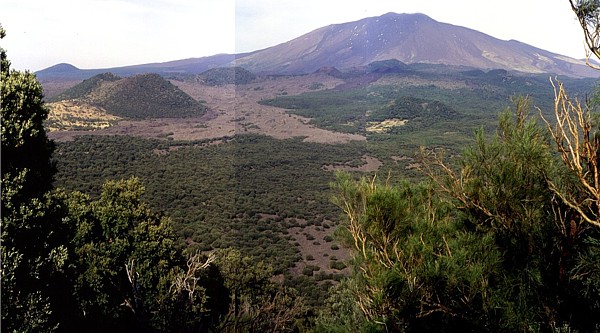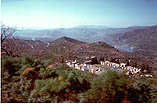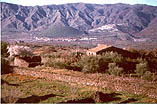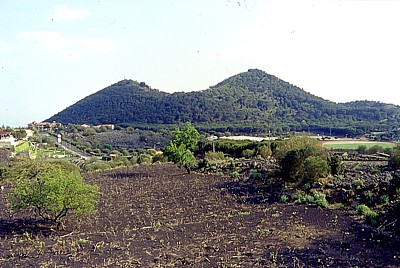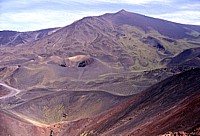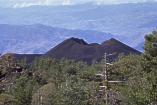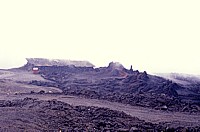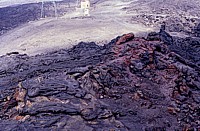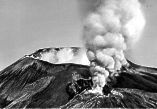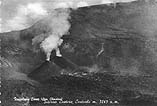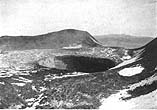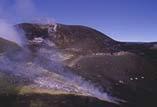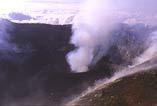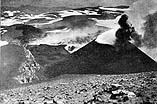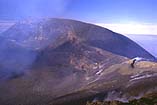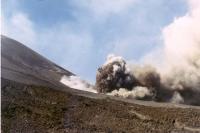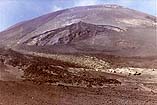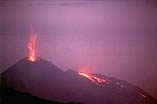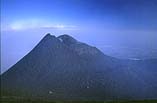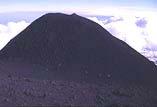| Etna
index |
||
| Geology | Geological history | Cones and craters |
| Eruptive characteristics | Eruptions before 1971 | Eruptions since 1971 |
| Etna and Man | References | Web sites |
| Weather forecasts | FAQ | Latest news |
Main summit cone (left) and Southeast Crater, with small black 1971 cone in foreground (photographed from south in August 1991)
Morphologic features: Cones and craters
Mount
Etna is a highly complex volcano whose history has been characterized
by the construction of numerous volcanic edifices at shifting locations
and repeated catastrophic collapse of these structures. The recent and
currently active volcanic edifice (Recent Mongibello) has a summit cone
complex and hundreds of cinder and spatter cones, pit craters, and spatter
ramparts along eruptive fissures scattered over its flanks. The number
of individual flank eruptive centers is more than 300, with new such structures
added in almost each flank eruption, most recently in the winter of 2002-2003.
Summit activity occurs at four craters: the Voragine and the Bocca Nuova,
which lie in the area of the former Central Crater, and the Northeast
(NE) and Southeast (SE) Craters. The latter have built sizeable cones
- referred to as the Northeast and Southeast Crater cones - leaning against
the bulky main summit cone that hosts the Voragine and the Bocca Nuova.
Among the most remarkable features of Etna's eruptive behavior is the
capability of the volcano to erupt from many places from its flanks, while
activity in the summit area is essentially concentrated at the four summit
craters, which remain in stable positions since decades and are frequently
active.
In the following, first some remarks are made about flank vents before a longer section deals with the summit craters and their evolution and behavior. Eruptive histories of these craters as well as flank eruptions are treated in the chronologic section of the Etna pages.
Flank eruptive centers. The size of the flank cones varies significantly, as illustrated in the photos below, depending on the explosivity and duration of an eruption. Eruptions farther downslope tend to build larger and more isolated cones (such as the conspicuous Monte Rossi near Nicolosi, formed in the 1669 eruption) while rows or chains of cones, often of small dimensions, are constructed at eruptive sites at higher locations. One of the most impressive chains of eruptive cones is Monti Silvestri at the 1892 eruption fissure, close to the tourist facilities near Rifugio Sapienza, on the southern flank of Etna.
Many of Etna's flank cones have horseshoe-shaped craters, which are commonly open on the downslope side. While such a morphology can be due to the preferential accumulation of ejected pyroclastics on the leeward side - which will occur primarily during a relatively short-lived eruption that occurs during strong wind - most of the horseshoe-shaped cones owe their morphology to the outflow of lava from their vents on the downslope side. The more or less continuous outflow of lava prevents the accumulation of pyroclastics to build a high rim on this side. However, quite a significant proportion of the flank cones are symmetrical and not open on one side; in these cases lava effusion occurred from vents located on the lower flanks or at the base of the cones, as has also been observed at some of the cones formed during the 2001 and 2002-2003 flank eruptions. The large cones of Monte Minardo and Monte Ruvolo on the western flank and Monte Ilice and Monte Gorna on the southeastern flank are examples of this type. But even most of the more regularly shaped flank cones have several summit vents, which has led to the formation of more or less deep notches in the crater rims.
Etna's flank cones are not distributed regularly over the flanks of the volcano, but they tend to be clustered in certain areas pertaining to more or less defined rift zones (see map). The most conspicuous rift zone lies on the northeastern flank and is marked by the presence of numerous linear crater groups and gaping fractures. A less defined rift zone lies on the south flank between 2600 and 1600 m elevation; below 1600 m, this rift zone extends into a fan-shaped sector (on the lower southeastern flank of the mountain) with numerous large and isolated cones. This latter sector is the most densely populated areas on Etna, and the presence of several historical eruptive centers amidst this growing urban agglomerate is of great significance for volcanic hazard considerations at Etna.
The
summit craters. Etna's
summit is occupied by a large cone complex including the original Central
Crater (now nearly substituted by the two craters Bocca Nuova and Voragine),
the NE Crater and the SE Crater. The latter two craters are relatively
recent features: the NE Crater first formed in 1911 and the SE Crater
was born in 1971. While previously being considered "subterminal"
vents by many authors, these two craters have become very large and high
structures in recent years, the summit of the NE crater being the highest
point of Etna between 1978 and 1986 and possibly again since 1996, so
they are now rather considered genuine summit craters.
The Central
Crater, the Voragine and Bocca Nuova. Before 1911, the central summit
cone was a broad structure 250 m high whose top was truncated by the 500
m-diameter Central Crater. Historical records indicate that this cone
formed within about one century following the collapse of a preceding
summit cone during the catastrophic 1669 eruption. Lava overflows from
the Central Crater or from vents on the flanks of the central summit cone
occurred frequently until 1869, and an eruption from the Central Crater
in July 1787 was among the most violent documented eruptions of Etna in
historical times, generating lava fountains up to 3000 m high and flows
that extended up to 5 km to SW and W.
During the late 19th and early 20th centuries, the Central Crater was a single deep pit with near vertical walls, with its depth varying between 150 and more than 200 m. Between 1916 and 1922 more or less continuous eruptive activity occurred at a cluster of vents in the NE part of the crater, building a large cone which became known locally as the "cono avventizio". The central portion of the crater was gradually filled with pyroclastics and lava flows, which formed a flat terrace. In mid-1922 this period of crater filling ended and a new collapse pit formed in the center of the terrace; collapse also removed nearly all of the "cono avventizio". A new period of rapid crater filling began in 1939, the main focus of eruptive activity once more lying at the site of the former "cono avventizio". Intermittent Strombolian and effusive activity built new cones and the central pit was filled with lava, so that no trace of it was visible by mid-1940. Renewed activity in the first half of 1942 added more lava and pyroclastics before a violent paroxysmal eruption on 5 July 1942 completely overwhelmed the topography of the Central Crater. A 30 m thick sheet of lava covered nearly all of the crater floor and obliterated any trace of the pyroclastic cone in its NE part. These conditions are clearly shown in an impressive aerial photo taken in 1943 which was published in Chester et al. (1985). A small collapse pit formed in the northeastern part of the Central Crater platform in late-October 1945, which became soon known as the Voragine, or "the Chasm".
Vigorous eruptions in the 1950's and early 1960's built large cones in the central and southern parts of the summit crater platform while the Voragine collapse pit in the NE part of the crater gradually enlarged. The culminating event, in 1964, was the growth of a two large cones - one around the Voragine, and another around a new vent (the 1964 crater) on its southern side- to several tens of meters above the summit platform. This cone raised Etna's summit to 3330 m, an elevation only to be surpassed by the NE Crater in the late 1970's. The Central Crater was filled completely during this period, and voluminous lava overflows in 1956, 1961 and most notably in 1964 extended up to 4 km towards N, NE, NW, W, SSW and SE.
In 1968, a small pit - the Bocca Nuova, the "new mouth" - opened on the W flank of the large cone formed in 1964 around the Voragine. While its initial diameter was only 8 m, collapse of its walls in the almost 30 years since have enlarged this pit to a gaping crater some 350 m across (as of late 1997). Most of the cones formed between 1955 and 1964 have been engulfed by the collapse of the walls of Boca Nuova, reducing the height of what remains of the main 1964 cone to about 3310 m elevation.
Since the growth of the last major structure on the summit crater platform in 1964, collapse of the Bocca Nuova and the Voragine have alternated with the partial infilling of both pits. In several cases magma rose within the Voragine pit almost to its lip (such as in the spring of 1980), and small cones and intracrater lava fields grew within the Bocca Nuova at various times. During the summer of 1997, a period of rapid filling of the Bocca Nuova and the Voragine began that continued, with interruptions, until late summer 1998. Meanwhile the septum separating both pits (the so-called "diaframma") partially collapsed, mostly during the 22 July 1998 eruption from the Voragine. Further collapse occurred there during another strong Voragine eruption on 4 September 1999. The latest chapter in the saga of these two craters is the nearly complete filling of the Bocca Nuova in October-November 1999, which led to the first overflows of lava from this crater onto the external slopes of Etna, and the burial of the "diaframma" under a large pyroclastic cone. Since the end of that eruption, two major pits are present within the Bocca Nuova, in the NW and SE of the crater. Activity within these pits in late-2000 and early-2001 repeated the history of the Bocca Nuova, with periods of filling alternating with collapse.
The NE and SE Craters. Both the NE and the SE Craters started in a very similar manner as collapse pits on the flanks of the main summit cone. In the case of the latter, the initial stages of its formation are well documented. The SE Crater started as a degassing pit during the late stages of the peculiar 1971 eruption and remained inactive thereafter until spring 1978. Since then, it has been the site of six major eruptions, some of which were closely related to eruptions on the upper flanks of Etna. The most significant events during the brief history of the SE Crater were the episodes of vigorous lava fountaining preceding and following the 1989 flank eruption, culminating in one of the most violent eruptions of Etna in recent decades, on 5 January 1990. Between late 1996 and July 1998, the crater showed continuous Strombolian and effusive activity characterized by relatively low eruption rates; from September 1998 until February 1999 it was again the site of 22 powerful eruptive episodes that built the cone to an unprecedented height of about 3260 m. Between 26 January and 29 August 2000, the SE Crater was the site of 66 (sixty-six) violent eruptive episodes, and sixteen further paroxysms occurred between 9 May and 17 July 2001. These events led to further growth of the SE Crater cone, which by early 2001 had reached 3300 m elevation.
The growth of the NE Crater was interrupted by repeated collapse throughout the 1950's, and it was only during that decade that a large cone began to develop within the collapse structure. This was accompanied by voluminous outflows of lava which created a vast lava apron around the base of the cone except on its S side, and lava extended far down the NW, N and NE flanks. Vigorous growth of the cone and the surrounding lava field occurred again from 1966 until 1971, a period characterized by what became famous as "persistent activity" with continuous Strombolian bursts and slow lava effusion, mostly from vents on the flanks or at the base of the pyroclastic cone. The largest of these formed in 1970 and was nicknamed "Nordestino" (little Northeast) by the local mountain guides.
In another eruptive period lasting from 1974 until early 1977, similar persistent activity was accompanied by effusion from boccas farther downslope on the N flank, but still related to NE Crater. In the summer of 1977, the crater changed its behavior, producing a series of short-lived but violent eruptions that ended in late March 1978. These were characterized by high lava fountains and voluminous lava effusion from the main vent with flows extending as far as 7 km downslope; the cone was eventually breached on its NW side during one of these episodes. Similar episodes of activity occurred in September 1980 and February 1981. The most violent eruption of NE Crater so far occurred in September 1986 and ended with the partial destruction of the cone after which there was little eruptive activity for the next nine years. Collapse of the internal parts of the crater occurred frequently during and after the large 1991-1993 eruption in Valle del Bove.
In late 1995, a new series of paroxysmal eruptions with high lava fountains started, followed by Strombolian and effusive activity in the summer of 1996. This activity and ensuing collapse completely altered the morphology of the crater. Another paroxysmal eruption on 27 March 1998 and mild Strombolian activity deep in the collapse pit in the summer of 1998 did not result in further significant morphological changes, but the powerful Voragine eruption on 22 July 1998 caused the collapse of the southern flank of the NE Crater cone and deposited several meters of pyroclastics on its summit. A new period of Strombolian activity within the central pit of the Northeast Crater between June and September 2002 led to the temporary filling of the pit to about 50 m below its rim, but subsequent collapse (related to the flank eruption in October-November 2002 on the Northeast Rift) enlarged the pit to the west rim of the crater and re-transformed it into a bottomless abyss.
The Southeast Crater has experienced a story very similar to that of the NE Crater which has already been summarized above. Its life began during the latest stage of the fascinating 1971 eruption when eruptive fractures opened across the upper western and northwestern part of the Valle del Bove, giving lava flows that caused serious damage to forests, fruit gardens, and isolated buildings uncomfortably close to the village of Fornazzo. While lava flowed quietly from the lowermost vents, outside the northern rim of Valle del Bove, a degassing pit formed on the southeastern base of the main summit cone, erupting steam and ash. This pit, later named Southeast Crater, remained silent for seven years after the 1971 eruption and then became the site of frequent eruptions that continue to the present day.
Some of the SE Crater eruptions were particularly violent, like those of early August 1979 and September 1989-February 1990 and especially those seen between late 1998 and mid-2001, and consisted of brief episodes of high lava fountaining accompanied by voluminous outflow of lava. Other eruptions, like one in 1984 and more recently, in 1997-1998, were characterized by mild Strombolian activity and slow lava effusion; these eruptions lasted months to years and were type examples of the "persistent summit activity" observed in the 1950's to 1970's at NE Crater.
Copyright © Boris Behncke, "Italy's Volcanoes: The Cradle of Volcanology"

